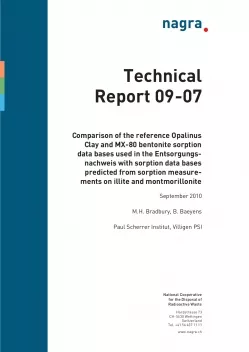
Technical Report NTB 09-07
Comparison of the reference Opalinus Clay and MX-80 bentonite sorption data bases used in the Entsorgungsnachweis with sorption data bases predicted from sorption measurements on illite and montmorillonite
In Stage 2 of the Sectoral Plan for 'Deep Geological Disposal' preliminary safety analyses will be carried out for potential sites identified within regions previously selected as being suitable for constructing HLW and L/ILW radioactive waste repositories. The rock formations in question are Opalinus Clay (HLW, L/ILW) and 'Brauner Dogger', Effingen Member and Helvetic Marl (L/ILW). Sorption data bases for all of these host rocks are required to perform the planned preliminary safety analyses.
In a previous report (Bradbury et al. 2010), a methodology was described for developing sorption data bases for argillaceous rocks, so called Generic Rock Sorption Data Bases. In Bradbury et al. (2010) it was argued that the main factor influencing sorption on argillaceous rocks is the phyllosilicate mineral content, particular the 2:1 clay mineral content (illite/smectite/illite-smectite mixed layers). The second important influence is the water chemistry which determines the radionuclide species in the aqueous phase. Primarily sorption measurements on illite were used and these data were converted to the defined conditions in the argillaceous rock by using a series of so called conversion factors to take into account differences in mineralogy, in pH and in radionuclide speciation. Finally, a Lab→Field conversion factor (CFLab→Field) was applied to adapt sorption data measured in dispersed systems (batch experiments) to intact rock under in-situ conditions. The intention in Stage 2 of the Sectoral Plan is to use this methodology to develop sorption data bases (SDB) for the host rocks under consideration (Opalinus Clay, 'Brauner Dogger', Effingen Member and Helvetic Marl).
Since this methodology for generating SDBs is relatively new, a direct means of creating confidence in its application and verifying its applicability was required. Hence, it was decided to compare and contrast the sorption values obtained in the manner described above with those in an already existing SDB for Opalinus Clay used in the Entsorgungsnachweis (Nagra 2002).
In order to test the procedure further, a second such study was undertaken with MX-80 bentonite. A SDB for MX-80 bentonite was derived from measurements made on montmorillonite using the same methodology and compared with the values used in the Entsorgungsnachweis (Nagra 2002).
The main conclusion from detailed comparisons made for both Opalinus Clay and MX-80 bentonite is that very strong evidence has been provided to demonstrate that the same basic approach as used here can be applied with confidence to other argillaceous rock systems for which direct sorption measurement data may be sparse or missing.
